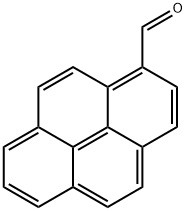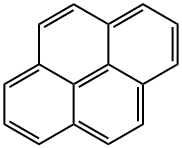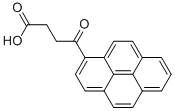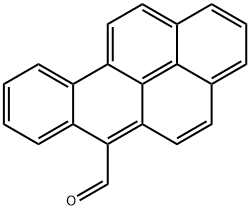1-Pyrenecarboxaldehyde
Synonym(s):1-Formylpyrene;1-Pyrenealdehyde;1-Pyrenecarbaldehyde;3-Pyrenylaldehyde
- CAS NO.:3029-19-4
- Empirical Formula: C17H10O
- Molecular Weight: 230.26
- MDL number: MFCD00004139
- EINECS: 221-196-6
- SAFETY DATA SHEET (SDS)
- Update Date: 2024-07-08 20:25:11

What is 1-Pyrenecarboxaldehyde?
Chemical properties
Dark Yellow Solid
The Uses of 1-Pyrenecarboxaldehyde
1-Pyrenecarboxaldehyde is a important intermediate used in agrochemical, pharmaceutical and dyestuff field. It is used as a highly polarity-sensitive fluorophore for SNP typing.
The Uses of 1-Pyrenecarboxaldehyde
A novel base-discriminating fluorescent (BDF) compound: a highly polarity-sensitive fluorophore for SNP typing.
What are the applications of Application
1-Pyrenecarboxaldehyde is a novel base-discriminating fluorescent (BDF) compound
Purification Methods
Recrystallise the aldehyde three times from aqueous EtOH. [Beilstein 7 IV 1821.]
Properties of 1-Pyrenecarboxaldehyde
| Melting point: | 123-126 °C (lit.) |
| Boiling point: | 312.25°C (rough estimate) |
| Density | 1.1350 (rough estimate) |
| refractive index | 1.4500 (estimate) |
| storage temp. | under inert gas (nitrogen or Argon) at 2-8°C |
| solubility | Chloroform (Slightly), Methanol (Slightly) |
| form | Solid |
| color | yellow |
| Water Solubility | Insoluble in water. |
| Sensitive | Air Sensitive |
| BRN | 1874889 |
| InChI | InChI=1S/C17H10O/c18-10-14-7-6-13-5-4-11-2-1-3-12-8-9-15(14)17(13)16(11)12/h1-10H |
| CAS DataBase Reference | 3029-19-4(CAS DataBase Reference) |
| NIST Chemistry Reference | 1-Pyrene-carboxaldehyde(3029-19-4) |
Safety information for 1-Pyrenecarboxaldehyde
| Signal word | Warning |
| Pictogram(s) |
 Exclamation Mark Irritant GHS07 |
| GHS Hazard Statements |
H315:Skin corrosion/irritation H319:Serious eye damage/eye irritation H335:Specific target organ toxicity, single exposure;Respiratory tract irritation |
| Precautionary Statement Codes |
P261:Avoid breathing dust/fume/gas/mist/vapours/spray. P264:Wash hands thoroughly after handling. P264:Wash skin thouroughly after handling. P271:Use only outdoors or in a well-ventilated area. P280:Wear protective gloves/protective clothing/eye protection/face protection. P302+P352:IF ON SKIN: wash with plenty of soap and water. P305+P351+P338:IF IN EYES: Rinse cautiously with water for several minutes. Remove contact lenses, if present and easy to do. Continuerinsing. |
Computed Descriptors for 1-Pyrenecarboxaldehyde
| InChIKey | RCYFOPUXRMOLQM-UHFFFAOYSA-N |
| SMILES | C1(C=O)=C2C3=C4C(C=C2)=CC=CC4=CC=C3C=C1 |
New Products
4-Aminotetrahydropyran-4-carbonitrile Hydrochloride (R)-3-Aminobutanenitrile Hydrochloride 4-AMINO-TETRAHYDRO-PYRAN-4-CARBOXYLIC ACID HCL 4-(Dimethylamino)tetrahydro-2H-pyran-4-carbonitrile 3-((Dimethylamino)methyl)-5-methylhexan-2-one oxalate 1,4-Dioxa-8-azaspiro[4.5]decane 5-Bromo-2-nitropyridine Nimesulide BP Aceclofenac IP/BP/EP Mefenamic Acid IP/BP/EP/USP Diclofenac Sodium IP/BP/EP/USP Ornidazole IP Diclofenac Potassium SODIUM AAS SOLUTION ZINC AAS SOLUTION BUFFER SOLUTION PH 10.0(BORATE) GOOCH CRUCIBLE SINTERED AQUANIL 5 BERYLLIUM AAS SOLUTION 2-Bromo-1-(bromomethyl)-3-chloro-5-nitrobenzene 2-Bromo-3-nitroaniline N-(3-Hydroxypropyl)-N-methylacetamide 3-Bromo-6-chloropyridazine 4-ethyl-3-nitrobenzoic acidRelated products of tetrahydrofuran








You may like
-
 1-Pyrenecarboxaldehyde CAS 3029-19-4View Details
1-Pyrenecarboxaldehyde CAS 3029-19-4View Details
3029-19-4 -
 1-Pyrenecarboxaldehyde CAS 3029-19-4View Details
1-Pyrenecarboxaldehyde CAS 3029-19-4View Details
3029-19-4 -
 Pyrene-1-carbaldehyde 98.00% CAS 3029-19-4View Details
Pyrene-1-carbaldehyde 98.00% CAS 3029-19-4View Details
3029-19-4 -
 Pyrene-1-carbaldehyde 98% CAS 3029-19-4View Details
Pyrene-1-carbaldehyde 98% CAS 3029-19-4View Details
3029-19-4 -
 1-Pyrenecarboxaldehyde CAS 3029-19-4View Details
1-Pyrenecarboxaldehyde CAS 3029-19-4View Details
3029-19-4 -
 1823368-42-8 98%View Details
1823368-42-8 98%View Details
1823368-42-8 -
 2-(3-(tert-butyl)phenoxy)-2-methylpropanoic acid 1307449-08-6 98%View Details
2-(3-(tert-butyl)phenoxy)-2-methylpropanoic acid 1307449-08-6 98%View Details
1307449-08-6 -
 Lithium ClavulanateView Details
Lithium ClavulanateView Details
61177-44-4
Statement: All products displayed on this website are only used for non medical purposes such as industrial applications or scientific research, and cannot be used for clinical diagnosis or treatment of humans or animals. They are not medicinal or edible.